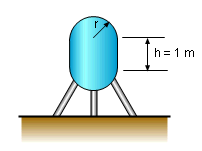| Ch 3. Derivatives II | Multimedia Engineering Math | ||||||
|
Higher Order Derivatives |
Related Rates |
Differential |
Newton's Method |
||||
| Newton's Method | Case Intro | Theory | Case Solution |
| Chapter |
| 1. Limits |
| 2. Derivatives I |
| 3. Derivatives II |
| 4. Mean Value |
| 5. Curve Sketching |
| 6. Integrals |
| 7. Inverse Functions |
| 8. Integration Tech. |
| 9. Integrate App. |
| 10. Parametric Eqs. |
| 11. Polar Coord. |
| 12. Series |
| Appendix |
| Basic Math |
| Units |
| eBooks |
| Dynamics |
| Fluids |
| Math |
| Mechanics |
| Statics |
| Thermodynamics |
| ©Kurt Gramoll |
| MATHEMATICS - CASE STUDY SOLUTION |
||
 Vessel |
The container consists of three parts. A
half sphere on the top, a cylindrical in the middle and another half
sphere on the bottom. The volume of the container must be 1.5 m3.
The height of the cylindrical is 1 m. What is the radius of the container?
v = πr2h + 2(3πr3/8) = πr2h + 3πr3/4 Substituting h = 1 m into the above equation gives v = πr2 + 3πr3/4 The function v = πr2 + 3πr3/4 is plotted in the diagram on the left. This curve intersects the line v = 1.5 around 0.65. Start Newton's Method to solve the equation v(r) =1.5 with r1 = 0.65 as the starting point. First, calculate the derivative of the volume, v, with respect to the radius, r f '(r) = dv/dr = d(πr2 + 3πr3/4)/dr = d(πr2)/dr + d(3πr3/4)/dr = 2πr + 9πr2/4 Newton's Method gives x2 = x1 - f(x1)/ f '(x1). When r1 = 0.65, v and f '(r) can be calculated. v1 = πr12 + 3πr13/4 -1.5 = π(0.65)2 + 3π(0.65)3/4 -1.5 = 0.474 f '(r1) = 2πr1 + 9πr12/4 = 7.071 r2 can be found with Newton's Method as r2 = r1 - v1/ f '(r1) = 0.65 - 0.14/6.315 = 0.583 Now use r2 = 0.583 as the starting point for the second iteration. v2 = πr22 + 3πr23/4 -1.5 = π(0.583)2 + 3π(0.585)3/4 -1.5 = 0.035 f '(r2) = 2πr2 + 9πr22/4 = 6.066 r3 can be found as r3 = r2 - v2/ f '(r2) = 0.583 - 0.035/6.066 = 0.577 m More iterations can be processed, however, the result will be closer and closer to 0.577 m. For the vessel to hold 1.5 m3, its radius must be about 0.577 m. |
|